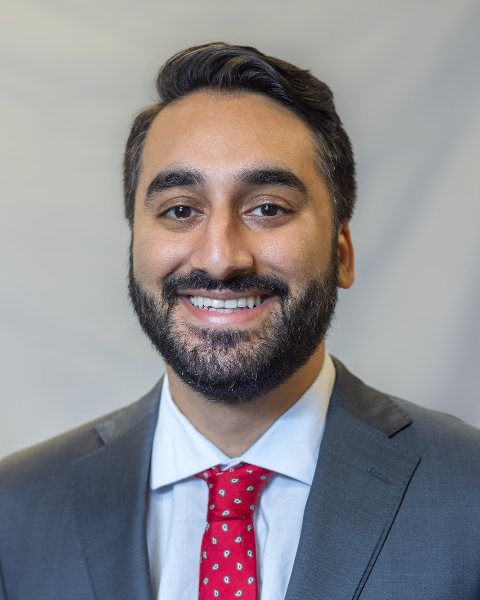PQA 03 - PQA 03 Gynecological Cancer, Pediatric Cancer, and Professional Development Poster Q&A
3505 - Long Term Proton Therapy Outcomes in the Reirradiation Setting for Recurrent Pediatric Ependymoma
Monday, September 30, 2024
8:00 AM - 9:00 AM ET
Location: Hall C
Screen: 13

Gobind Gill, MD
University of Alabama at Birmingham
Birmingham, AL
Presenter(s)
G. S. Gill1, K. W. Allison2, B. Bajaj2, S. Gallotto2, M. P. Lawell2, B. Patteson3, S. Baliga4, L. Wiltsie5, D. H. Ebb5, N. J. Tarbell2, S. M. MacDonald2, and T. I. Yock2; 1Department of Radiation Oncology and Applied Sciences, Dartmouth Cancer Center, Dartmouth Health, Lebanon, NH, 2Department of Radiation Oncology, Massachusetts General Hospital, Harvard Medical School, Boston, MA, 3Department of Pediatric Hematology & Oncology, Childrens Healthcare of Atlanta, Atlanta, GA, 4Department of Radiation Oncology, The Ohio State University, Columbus, OH, 5Department of Pediatric Hematology & Oncology, Massachusetts General Hospital, Harvard Medical School, Boston, MA
Purpose/Objective(s): The objective of this study was to update a previously reported retrospective series with long-term outcomes on the efficacy and safety of re-irradiation with proton therapy for recurrent ependymoma. Materials/
Methods: With IRB approval, we searched our pediatric database to identify children with a diagnosis of ependymoma who received at least two courses of radiation therapy. Only patients who received proton therapy for their re-irradiation were included in our analysis. Progression free survival (PFS) and overall survival (OS) were calculated using the Kaplan-Meier method from the start date of the second radiation.
Results: The median age at re-irradiation was 8.5 years (n=35). The majority of patients were female (57%) with anaplastic histology (71%), infratentorial tumors (69%), and received a median of 54.0 Gy (52.2-59.4) with proton radiation therapy (86%) for their initial treatment. The median time to first failure was 2.39 years from the initial treatment. The most common site of first failure was local (77%) followed by distant (14%) and both (9%). Salvage therapy typically included re-resection (83%), chemotherapy (57%), and proton radiation therapy (100%) to a median dose of 52.2 GyE (14.0 – 58.0). The median time to second failure was 1.16 years from the second treatment. The most common site of second failure was local (64%) followed by distant (32%) and both (4%). The median follow up was 5.22 years (0.9-14.0). Six-year OS and PFS are 55.5% (39.9-76.2) and 25.5% (13.5-45.1). An improved OS was associated with patients who did not receive chemotherapy as part of the treatment for their first recurrence (HR 3.17, p = 0.014). Four of 30 patients (13.3%) locally re-treated experienced grade 2 radiation-associated treatment change and 1 patient (3.3%) experienced a grade 3 radiation-associated treatment change.
Conclusion: Among a cohort of patients with long-term follow up, proton therapy remains a safe and effective option for re-irradiation in the treatment of recurrent ependymoma and can be an effective salvage strategy for patients with recurrent disease.
Purpose/Objective(s): The objective of this study was to update a previously reported retrospective series with long-term outcomes on the efficacy and safety of re-irradiation with proton therapy for recurrent ependymoma. Materials/
Methods: With IRB approval, we searched our pediatric database to identify children with a diagnosis of ependymoma who received at least two courses of radiation therapy. Only patients who received proton therapy for their re-irradiation were included in our analysis. Progression free survival (PFS) and overall survival (OS) were calculated using the Kaplan-Meier method from the start date of the second radiation.
Results: The median age at re-irradiation was 8.5 years (n=35). The majority of patients were female (57%) with anaplastic histology (71%), infratentorial tumors (69%), and received a median of 54.0 Gy (52.2-59.4) with proton radiation therapy (86%) for their initial treatment. The median time to first failure was 2.39 years from the initial treatment. The most common site of first failure was local (77%) followed by distant (14%) and both (9%). Salvage therapy typically included re-resection (83%), chemotherapy (57%), and proton radiation therapy (100%) to a median dose of 52.2 GyE (14.0 – 58.0). The median time to second failure was 1.16 years from the second treatment. The most common site of second failure was local (64%) followed by distant (32%) and both (4%). The median follow up was 5.22 years (0.9-14.0). Six-year OS and PFS are 55.5% (39.9-76.2) and 25.5% (13.5-45.1). An improved OS was associated with patients who did not receive chemotherapy as part of the treatment for their first recurrence (HR 3.17, p = 0.014). Four of 30 patients (13.3%) locally re-treated experienced grade 2 radiation-associated treatment change and 1 patient (3.3%) experienced a grade 3 radiation-associated treatment change.
Conclusion: Among a cohort of patients with long-term follow up, proton therapy remains a safe and effective option for re-irradiation in the treatment of recurrent ependymoma and can be an effective salvage strategy for patients with recurrent disease.
